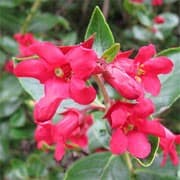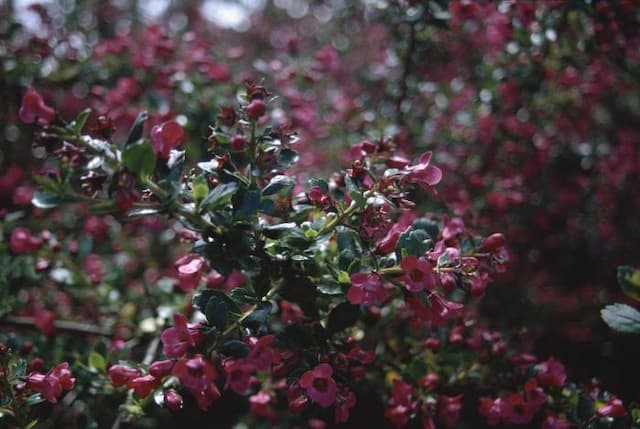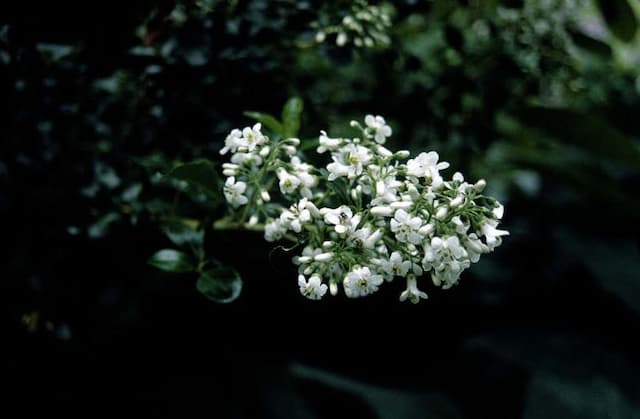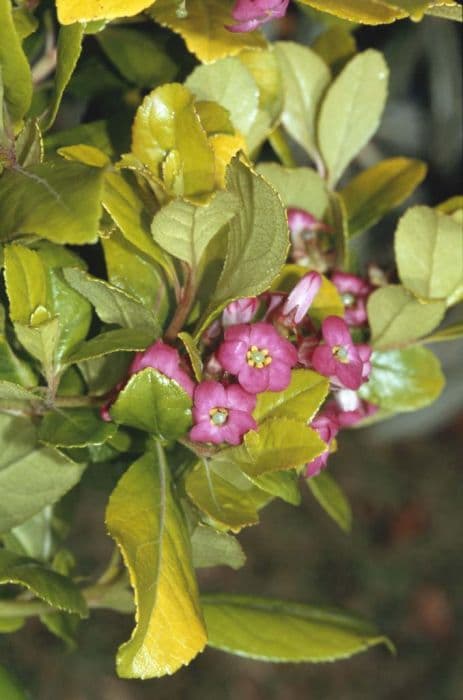Glowing Embers Escallonia Escallonia Glowing Embers = 'Lowat21'

ABOUT
Escallonia Glowing Embers, known as 'Lowat21', is a vibrant, evergreen shrub that captures attention with its dense, glossy green foliage that serves as a luscious backdrop to its striking flowers. The leaves of this Escallonia are small, neat, and oval-shaped with a slightly serrated edge, giving the plant a textured and lush appearance. Throughout the blooming season, it becomes adorned with clusters of small, tubular flowers. The blooms are a fiery shade of red-orange, reminiscent of glowing embers, hence its name. These vivid flowers not only add a burst of color to the foliage but also attract a variety of pollinators, including bees and butterflies, adding movement and life to the garden. The flower clusters are tight and profuse, creating a spectacular and eye-catching display against the verdant green leaves. The plant's overall form is bushy and well-branched, which allows it to create a substantial presence in any planting area, contributing to an array of garden designs from hedging to ornamental showcases.
About this plant
 Names
NamesSynonyms
Escallonia 'Glowing Embers', Escallonia 'Lowat21'.
Common names
Escallonia 'Lowat21'.
 Toxicity
ToxicityTo humans
Escallonia, including the variety known as Glowing Embers, is not generally considered to be toxic to humans. There is no significant evidence suggesting that ingesting parts of this plant would lead to severe poisoning. However, it is always advisable to exercise caution and avoid ingesting parts of ornamental plants due to potential individual allergic reactions or possible gastrointestinal discomfort.
To pets
Escallonia is not known to be toxic to pets, including common household pets such as dogs and cats. While there is no widely recognized toxicity, it is still best to prevent pets from ingesting the plant. Some animals may experience mild gastrointestinal upset if they consume parts of the plant, which could result in symptoms like vomiting or diarrhea. As with any non-food plant, it's wise to monitor your pet and consult with a vet if any concerning symptoms arise after ingestion.
 Characteristics
CharacteristicsLife cycle
Perennials
Foliage type
Evergreen
Color of leaves
Green
Flower color
Red
Height
3-4 feet (0.91-1.22 meters)
Spread
3-4 feet (0.91-1.22 meters)
Plant type
Shrub
Hardiness zones
7-10
Native area
South America
Benefits
 General Benefits
General Benefits- Attractive blooms - Escallonia Glowing Embers produces vibrant flowers that add a splash of color to the garden.
- Drought tolerance - Once established, it requires minimal watering and can survive dry periods.
- Low maintenance - This plant needs little pruning and care, making it ideal for gardeners of all skill levels.
- Hardy nature - It's resilient to many pests and diseases, reducing the need for chemical treatments.
- Habitat for wildlife - The flowers attract pollinators like bees and butterflies, supporting local ecosystems.
- Versatile landscaping - Can be used for hedges, borders, or as a standalone specimen due to its dense foliage.
- Evergreen foliage - Provides year-round greenery and structure in the garden.
- Fast growing - Quickly reaches mature size, providing quick coverage and landscape impact.
- Wind resistance - Makes an effective windbreak in coastal or exposed sites. < li>Deer resistance - Less likely to be damaged by deer, hence good for areas with a large deer population.
 Medical Properties
Medical PropertiesThis plant is not used for medical purposes.
 Air-purifying Qualities
Air-purifying QualitiesThis plant is not specifically known for air purifying qualities.
 Other Uses
Other Uses- Erosion control: Escallonia Glowing Embers can be used on slopes and banks to help stabilize the soil and prevent erosion due to its dense and robust root system.
- Windbreak: The plant can be used to create a natural barrier against strong winds, especially in coastal areas where the plants are tolerant to sea sprays.
- Privacy screen: When planted in rows or hedges, Escallonia Glowing Embers provides a thick screen that can help increase privacy in gardens and outdoor spaces.
- Noise reduction: The dense foliage of this plant can help absorb sound, making it a good option for planting along roadsides or in urban gardens to reduce traffic noise.
- Bee and butterfly garden: As a flowering shrub, it attracts pollinators, making it an ideal choice for gardens designed to support bee and butterfly populations.
- Foundation planting: The compact growth habit of Escallonia Glowing Embers makes it suitable for planting around building foundations to enhance curb appeal without risking damage to structures.
- Topiary or bonsai: With pruning, it can be trained into topiary shapes or grown as a bonsai, providing an artistic element to gardens and indoor displays.
- Seaside gardens: This plant's tolerance to salt makes it particularly suitable for seaside gardens, where it can thrive despite challenging conditions.
- Landscape design: The vibrant flowers and year-round foliage can be used to create interesting color contrasts in landscape designs.
- Potted specimen: Escallonia Glowing Embers can be grown in containers for patios, terraces, or even as a gift, offering flexibility in placement and ease of care.
Interesting Facts
 Feng Shui
Feng ShuiThe Escallonia is not used in Feng Shui practice.
 Zodiac Sign Compitability
Zodiac Sign CompitabilityThe Escallonia is not used in astrology practice.
 Plant Symbolism
Plant Symbolism- Renewal - Escallonia Glowing Embers, with its rejuvenating bright flowers, symbolizes the idea of renewal and beginning anew.
- Vibrancy - The vivid colors of this plant represent liveliness and energy, reminding us to embrace life with zest and enthusiasm.
- Resilience - Escallonia is known for its hardiness and ability to thrive in various conditions, representing the trait of resilience in adversity.
- Protection - In some cultures, Escallonia plants are believed to offer protection to the households due to their robust nature.
- Passion - The fiery appearance of Glowing Embers suggests a symbolism of intense feelings and passionate love.
 Water
WaterEscallonia 'Glowing Embers' should be watered regularly to maintain evenly moist soil, especially during the first growing season to establish a deep root system. Once established, they are somewhat drought tolerant. Watering every week with approximately 1 to 1.5 gallons of water is generally sufficient, but this can vary depending on climate and soil conditions. In hot, dry periods, watering frequency may increase. It's best to water deeply and less frequently, rather than little and often, to encourage deep root growth.
 Light
LightEscallonia 'Glowing Embers' thrives in full sun to partial shade. The ideal spot for planting would receive unfiltered sunlight for at least six hours a day. However, in extremely hot climates, a location with morning sun and afternoon shade can help protect the plant from excessive heat stress.
 Temperature
TemperatureEscallonia 'Glowing Embers' prefer moderate temperatures and can tolerate a range from about 20°F to 90°F. Frost hardy, they can withstand occasional dips below the minimum but for ideal growth, maintaining temperatures between 60°F and 80°F is beneficial.
 Pruning
PruningPruning Escallonia 'Glowing Embers' helps maintain its shape and encourage denser foliage. Light pruning should be done in late winter or early spring before new growth begins. Prune lightly again after flowering to maintain the desired form. Avoid heavy pruning as it can reduce flowering.
 Cleaning
CleaningAs needed
 Soil
SoilEscallonia 'Glowing Embers', commonly known as Escallonia, thrives best in well-drained soil that is rich in organic matter. A mixture of loam, peat, and coarse sand in equal parts would create an ideal environment for this shrub. The pH of the soil should be slightly acidic to neutral, ideally between 6.0 and 7.0.
 Repotting
RepottingEscallonia 'Glowing Embers' should be repotted every 2-3 years, or when it outgrows its current container. This regular repotting will ensure that the plant has enough space for root growth and replenishment of nutrients in the soil.
 Humidity & Misting
Humidity & MistingEscallonia 'Glowing Embers' prefers moderate humidity levels but is quite adaptable to different conditions. It does not require high humidity and can tolerate the humidity levels typically found in outdoor environments.
 Suitable locations
Suitable locationsIndoor
Place Escallonia in bright, indirect light and away from drafts.
Outdoor
Plant in full sun to part shade, shelter from strong winds.
Hardiness zone
8-10 USDA
 Life cycle
Life cycleThe life cycle of the Escallonia 'Glowing Embers' begins with seed germination, where it breaks dormancy and starts to develop roots and shoots in favorable conditions of warmth and moisture. As a seedling, it prioritizes establishing a robust root system and begins to grow its first leaves, photosynthesizing to fuel further growth. This stage transitions to the vegetative phase, where the 'Glowing Embers' grows vigorously, producing dense foliage and branching out to form its mature shape. In the flowering stage, usually from early to mid-summer, the 'Glowing Embers' produces vibrant red-pink flowers that attract pollinators and contribute to its ornamental appeal. Once pollinated, the flowers develop into fruits, containing seeds that carry the genetic material for the next generation. Finally, after several years when the plant has matured and possibly reached the end of its lifespan, it will enter a phase of senescence, marked by a gradual decline in physiological functions, eventually leading to the plant's death.
 Propogation
PropogationPropogation time
Spring-Early Summer
The Escallonia 'Glowing Embers', more commonly referred to simply as Escallonia, is best propagated in the late spring to early summer when the plant's natural growth cycle is most active. The most popular method for propagating this shrub is through semi-hardwood cuttings. To do this, select a healthy, non-flowering shoot and cut a piece that is about 4-6 inches (10-15 cm) long, making sure to include at least two sets of leaves. The bottom set of leaves should be removed and the cut end can be dipped in rooting hormone to encourage root growth. The cutting should then be planted in a pot filled with a mix of peat and perlite or a similar well-draining propagation medium, and kept moist but not waterlogged. Covering the pot with a plastic bag can help to maintain humidity levels. Roots typically begin to develop within a few weeks, after which the new plant can be gradually acclimatized to less humid conditions before eventually being planted out.




![Escallonia [Golden Carpet]](/_next/image?url=https%3A%2F%2Fplants-admin.emdemapps.com%2Fimages%2Fplants%2F%2Fimages%2F604b59284be41.png&w=640&q=75)


![Escallonia [Pink Elle]](/_next/image?url=https%3A%2F%2Fplants-admin.emdemapps.com%2Fimages%2Fplants%2F%2Fimages%2F604b630962bc2.png&w=640&q=75)

